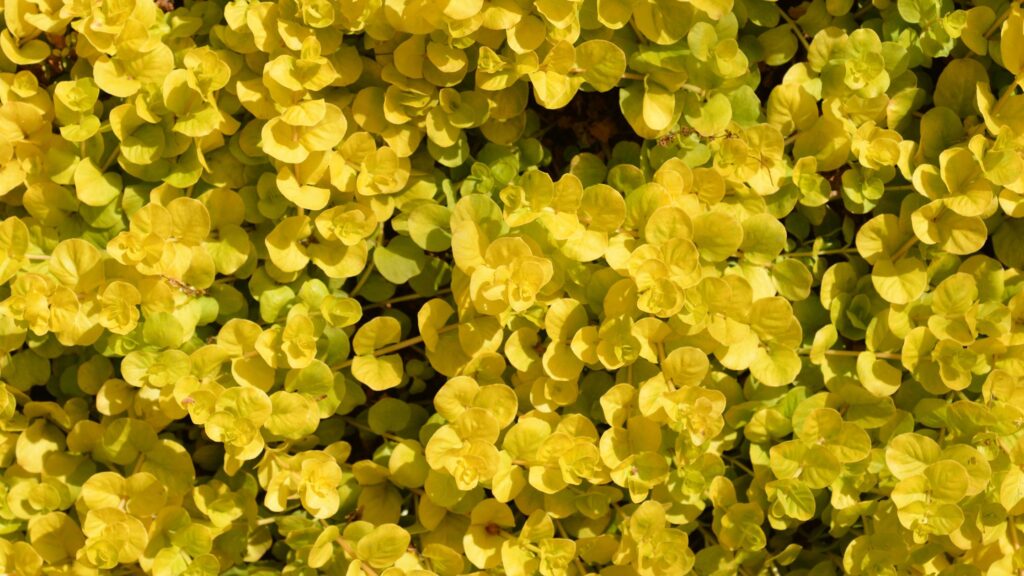Creeping Jenny, also known as moneywort (because its leaves resemble coins), is a perennial with bright, small yellow flowers. Though the blooms won’t last long, they are pretty. However, this low-growing “creeper” is best grown for its foliage, which makes an excellent ground cover.

Types of Creeping Jenny
There are two commonly grown varieties:
- Goldilocks Creeping Jenny
- Aurea Creeping Jenny
Golden creeping jenny

Here are some key details:
- Appearance: The leaves of Golden Creeping Jenny are shaped like tiny coins, with bright yellow and lime green colors. In full sunlight, they take on a brassy hue.
- Growth Habit: It’s a low-growing perennial that trails along the ground, creating a lush carpet of foliage.
- Hardiness Zones: Golden Creeping Jenny is hardy in USDA zones 4–9.
- Uses:
- Ground Cover: It makes an excellent ground cover due to its spreading habit.
- Containers: Use it as a “spiller” plant in pots and hanging baskets, where it cascades gracefully over the edges.
- Care Tips:
- Confirm its legality in your area, as it can be invasive.
- Plant it in a sunny or partially shaded spot with well-draining soil.
- Be cautious when disposing of pots, as seeds can escape and establish themselves elsewhere.
- Regular pruning may be necessary to control its spread
Benefits of Creeping Jenny
For your garden:
- Groundcover: Creeping Jenny fills empty spaces beautifully, suppressing weeds and preventing erosion.
- Moist soil indicator: This plant thrives in moist soil, so its wilting can be a signal to adjust watering for nearby plants.
- Pollinator attractor: The tiny yellow flowers attract butterflies and bees, boosting your garden’s ecosystem.
Potential medicinal uses (consult a doctor before using):
- Traditional applications: In some cultures, Creeping Jenny has been used for wound healing, calming the nervous system, and digestive issues.
- Anti-inflammatory properties: Research suggests it might have properties that reduce inflammation.
Other benefits:
- Low maintenance: Creeping Jenny is a forgiving plant, requiring minimal care to thrive.
- Easy propagation: Dividing the plant allows for effortless multiplication.
Disadvantages of Creeping Jenny
Here’s a breakdown of the disadvantages to consider:
- Invasiveness: This is the main concern. Creeping Jenny can aggressively spread, smothering other plants and taking over unwanted areas. In some regions, it’s considered invasive. Always check local regulations before planting.
- Difficult to control: Once established, especially in moist areas, Creeping Jenny can be challenging to contain. It roots easily from stem fragments, making weeding a constant battle.
- Not shade-friendly companions: While Creeping Jenny tolerates shade, it can become leggy and sparse in low-light conditions. It might outcompete desired shade-loving plants.
- Susceptibility to pests and diseases: Although generally healthy, Creeping Jenny can attract aphids, spider mites, and slugs. Fungal diseases like rust or leaf spots might occur in poorly drained or humid environments.
Creeping Jenny Care
Here’s a breakdown to keep it thriving:
Light: Creeping Jenny is adaptable, doing well in full sun to partial shade. However, the golden varieties (“Aurea”) tolerate more sun than the green ones. Avoid very hot, scorching locations.
Soil and Watering: They prefer moist, well-drained soil. Consistent moisture is key, so water regularly, especially during hot weather. Let the top inch of soil dry slightly between waterings to avoid oversaturation.
Fertilizing: During the growing season (spring and summer), a balanced fertilizer applied monthly can give your Creeping Jenny a boost. However, it’s not essential for established plants.
Pruning and Maintenance: Deadheading spent flowers encourages new blooms. Regular trimming helps maintain a desired shape and keeps the plant in bounds. Creeping Jenny can be easily propagated by division in spring or fall.
Winter Care: Creeping Jenny is winter hardy in USDA zones 4-9. In colder zones, it might benefit from a light layer of mulch around the base for extra protection.
Creeping Jenny seeds
Creeping Jenny is actually trickier to grow from seeds compared to other methods. Here’s the thing:
- Less common: While you might find Creeping Jenny seeds online or in some rare stores, propagation through seeds isn’t the most popular method. It can be less reliable and take longer than other options.
- Germination challenges: Creeping Jenny seeds can be slow to germinate and require specific conditions for success, like consistently moist soil and cool temperatures.
- Variability: Plants grown from seeds might not have the exact characteristics (like variegation) of the parent plant, unlike cuttings or divisions.



I have been absent for some time, but now I remember why I used to love this site. Thanks , I’ll try and check back more frequently. How frequently you update your website?
What fabulous ideas you have concerning this subject! By the way, check out my website at QU6 for content about Search Engine Optimization.
Very great post. I simply stumbled upon your blog and wished to say that I have truly enjoyed surfing around your weblog posts. In any case I will be subscribing for your rss feed and I hope you write once more very soon!